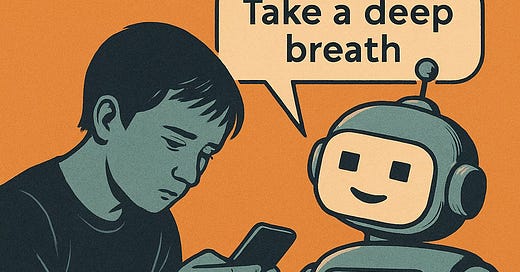There is a curious double-speak pulsing through today’s mental-health conferences and philanthropic webinars. We raise alarms that “Generation Alpha lives online,” wring our hands over their dopamine-flooded scrolls, and insist that the therapeutic playbooks of the last century are obsolete. Yet, in the same breath, we hail large language models—digital gargantuas trained on yesterday’s text—as the very oracles that will tell us how to rescue these young minds from the digital deluge. We applaud the elegance with which an algorithm can cluster Reddit confessions, generate an eight-point intervention plan, and spit out a chatbot that whispers mindfulness prompts at 2 a.m. But beneath the applause is an unspoken surrender: we are quietly outsourcing the most human part of healing—the raw telling and receiving of stories—to a machine whose genius is prediction, not presence.
This image is AI-generated from ChatGPT and does not represent real people or real situations. Any depictions of real people are entirely coincidental.
No one doubts that language models can summarize oceans of literature faster than any graduate assistant, or that they can crunch through terabytes of social-media slang to reveal patterns clinicians would otherwise miss. Their utility is undeniable. The danger lies in the subtle shift from tool to compass, from augmentation to authorship. Because an LLM is, at heart, an exquisite average. Its every sentence is the statistical midpoint of what has been said before. When we ask it to design new therapeutic frameworks for youth, it does so by remixing the linguistic DNA of prior generations—texts written largely by adults, for adults, about adults. It cannot feel the collective shiver in a grade-nine hallway after an image goes viral at lunchtime. It cannot taste the metallic fear of a 16-year-old whose private group chat is screenshotted and weaponized. It can only infer, with probabilistic confidence, the kind of sentence that usually follows the one you have just typed.
Proponents counter that nuance can be engineered: tune the model on focus-group transcripts, pipe in TikTok captions, filter with human-in-the-loop review. Yet even the most youth-centric dataset is only a fossilized snapshot of a culture that moves at the speed of memes. By the time we have scraped, cleaned, fine-tuned, and ethically audited those words, the slang has mutated, the platform has folded, and the feelings have morphed into something no longer legible to last month’s embeddings. The algorithm will dutifully echo what was true, not what is unfolding right now in a teenager’s bedroom while a faceless notification pulses on a cracked iPhone screen.
More insidious is what the model tends to erase. The edges—the hesitations, the stutters, the moments a young person says nothing at all because the pain has stolen their vocabulary—those absences are flattened into token counts and padded sequences. The code does not choke up when someone describes the smell of their father’s jacket after the overdose. It does not fumble for words or switch languages mid-sentence because certain feelings only fit in Urdu or Spanish or emoji. In our rush for scalable solutions, we risk turning lived experience into just another dataset for optimization, sandpapered smooth to fit neural-network pipelines. And we congratulate ourselves when the loss decreases by 0.02.
Storytelling, by contrast, is gloriously inefficient. It thrives on the digression, the trembling voice, the detail irrelevant to any clinical measure yet essential to human connection. When a youth worker leans forward and says, “Tell me what it was like the first time you logged on at three in the morning,” they invite a narrative that meanders, contradicts itself, circles back, and ultimately reveals a truth no model could have extracted. These stories are messy precisely because trauma and hope are messy. They do not lend themselves to tidy thematic clusters. To privilege them is to acknowledge that healing is relational, that growth is negotiated through eye contact, silence, and the tacit knowledge that your words are landing on another breathing being, not disappearing into a server farm in Utah.
This is not a Luddite manifesto. We will still use LLMs to flag warning signs no counselor could spot in a thousand Discord logs, to draft resource lists in plain language, to translate coping strategies into the vernacular of Minecraft. But let us keep them in their rightful place: backstage, toppling barriers, never taking the microphone. The main act must remain the encounter between two or more imperfect humans, co-constructing a narrative that makes sense of suffering and sketches a future chapter worth inhabiting.
If we hand the pen to an algorithm, we teach the next generation that their stories are best interpreted by a machinery of averages—that the singular contours of their grief or joy are optional data points in a generative loop. We risk breeding a cohort fluent in prompt engineering yet starved of real listeners. And paradoxically, we will arrive at interventions precisely calibrated to miss the point: treatments optimized for the metadata of youth experience, devoid of its pulse.
So recommit to storytelling. Fund the circles where teens swap tales without adult correction. Train clinicians to be witness before they are fixer. Archive voices in audio, not just transcripts, so future therapists can hear the crack, the sigh, the laughter. Use the silicon savant as a librarian, not an author. Because the algorithm may predict the next word, but only a human heart can absorb its weight—and offer one back that changes the story.
Healthcare Humanized™: www.youtube.com/@healthcarehumanized
The Academy of Research Methods™: https://learn.methodologists.org
LinkedIn: https://ca.linkedin.com/company/the-methodologists
The Methodologists (TMT)™. mobilizes organizations to design people-centred services through rigorous research and meaningful engagement.
Learn more about us and our services by visiting our website. You can also explore our YouTube channel, Healthcare Humanized™, or connect with us on LinkedIn. For support and services, reach out to us via email at info@methodologists.org.




